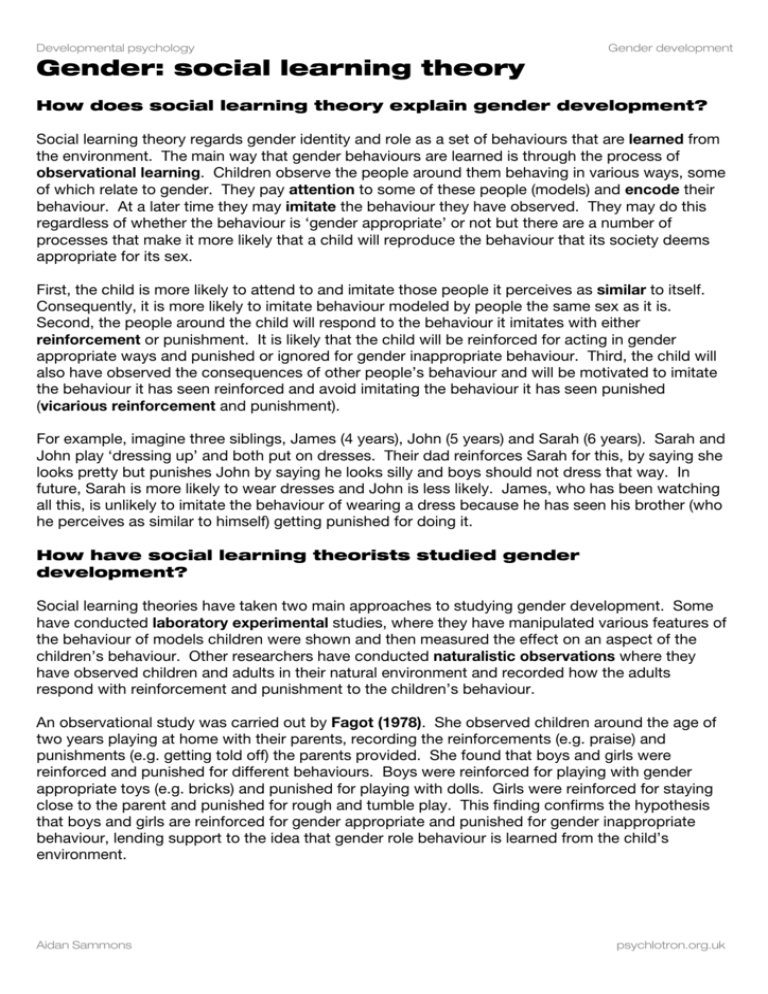Gender: social learning theory
advertisement

Developmental psychology Gender development Gender: social learning theory How does social learning theory explain gender development? Social learning theory regards gender identity and role as a set of behaviours that are learned from the environment. The main way that gender behaviours are learned is through the process of observational learning. Children observe the people around them behaving in various ways, some of which relate to gender. They pay attention to some of these people (models) and encode their behaviour. At a later time they may imitate the behaviour they have observed. They may do this regardless of whether the behaviour is ‘gender appropriate’ or not but there are a number of processes that make it more likely that a child will reproduce the behaviour that its society deems appropriate for its sex. First, the child is more likely to attend to and imitate those people it perceives as similar to itself. Consequently, it is more likely to imitate behaviour modeled by people the same sex as it is. Second, the people around the child will respond to the behaviour it imitates with either reinforcement or punishment. It is likely that the child will be reinforced for acting in gender appropriate ways and punished or ignored for gender inappropriate behaviour. Third, the child will also have observed the consequences of other people’s behaviour and will be motivated to imitate the behaviour it has seen reinforced and avoid imitating the behaviour it has seen punished (vicarious reinforcement and punishment). For example, imagine three siblings, James (4 years), John (5 years) and Sarah (6 years). Sarah and John play ‘dressing up’ and both put on dresses. Their dad reinforces Sarah for this, by saying she looks pretty but punishes John by saying he looks silly and boys should not dress that way. In future, Sarah is more likely to wear dresses and John is less likely. James, who has been watching all this, is unlikely to imitate the behaviour of wearing a dress because he has seen his brother (who he perceives as similar to himself) getting punished for doing it. How have social learning theorists studied gender development? Social learning theories have taken two main approaches to studying gender development. Some have conducted laboratory experimental studies, where they have manipulated various features of the behaviour of models children were shown and then measured the effect on an aspect of the children’s behaviour. Other researchers have conducted naturalistic observations where they have observed children and adults in their natural environment and recorded how the adults respond with reinforcement and punishment to the children’s behaviour. An observational study was carried out by Fagot (1978). She observed children around the age of two years playing at home with their parents, recording the reinforcements (e.g. praise) and punishments (e.g. getting told off) the parents provided. She found that boys and girls were reinforced and punished for different behaviours. Boys were reinforced for playing with gender appropriate toys (e.g. bricks) and punished for playing with dolls. Girls were reinforced for staying close to the parent and punished for rough and tumble play. This finding confirms the hypothesis that boys and girls are reinforced for gender appropriate and punished for gender inappropriate behaviour, lending support to the idea that gender role behaviour is learned from the child’s environment. Aidan Sammons psychlotron.org.uk Developmental psychology Gender development Evaluation of the social learning theory of gender A number of other studies have shown that girls and boys are reinforced and punished for different behaviours. For example Dweck et al (1978) found that teachers reinforced boys for getting things right but reinforced girls for working neatly. However, many such studies were conducted in the US in the 1970s, and their findings may not reflect gender socialization in other times and places. Cross cultural findings that show variations in gender role between different cultures (e.g. Mead’s study of three tribes in Papua New Guinea) are consistent with the idea that gender role behaviour is learned. However, a number of studies have found that parents do not directly teach gender role behaviours to their children through selective reinforcement and punishment but that children acquire gender appropriate behaviours nonetheless. It may therefore be that the learning of gender role occurs through processes other than those specified by social learning theory. Social learning theory has difficulty explaining how children’s understanding of gender changes over time. It also cannot easily account for how children’s preparedness to imitate a gender role behaviour depends more on whether the behaviour is seen as gender appropriate than the sex of the model demonstrating it. These findings suggest that cognitive processes play a greater role in the learning of gender than social learning theory allows for. There is also the issue that some aspects of gender role behaviour appear to be universal to all cultures. For example, men are consistently found to be more aggressive than women, regardless of culture. Similarly, there are cross-cultural similarities in the features women and men find desirable in potential reproductive partners (Buss et al, 1990). These universal features suggest that some aspects of gender role are the result of innate, genetic influences that social learning theory does not take account of. Aidan Sammons psychlotron.org.uk






